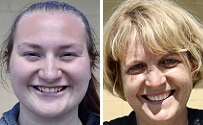
In Just 2nd Season, Van Dyk Breaks Decades-Old K-Christian Throws Records
By
Pam Shebest
Special for MHSAA.com
June 9, 2022
KALAMAZOO — When an exuberant Tess Van Dyk broke the shot put record at Kalamazoo Christian earlier this year, the senior was thrilled at reaching one of her high school goals.
 For her throws coach, Tracy (Rozema) Jackson, the achievement was bittersweet.
For her throws coach, Tracy (Rozema) Jackson, the achievement was bittersweet.
Jackson was the previous record-holder with a put of 41 feet, 6 inches, and knew that record was in jeopardy when she saw Van Dyk’s numbers a year ago.
“I thought, just wait and be prepared for it,” Jackson said. “It was kind of something sentimental. That record had been in place for 34 years. I set it in 1988.”
Van Dyk actually broke the record twice.
She put the shot 42 feet, 6 inches, to snap Jackson’s record, then the same day, threw the current mark of 42-9.
That happened during a dual meet April 21, and was just the start of a stellar year.
Van Dyk also shattered the previous discus throw record of 127 feet, 3 inches, set by Sandy (Wolthuis) George in 1978.
Van Dyk’s record-setter was 134-6, tossed at the Southwestern Athletic Conference championship meet May 24.
“When I started track, one of my big goals was to break either the shot put or discus record,” Van Dyk said. “I was like, before I leave this school, I want my name on that board.
“That’s what started me on the path to loving track and getting that grit for it.”
Since the records board has not yet been updated, the recent grad will have to return to the school to see her name up there. But her coach gave her a preview.
“I went into the gymnasium and I took a picture of the board with my name on it, then I covered it up with her name (using SnapChat),” Jackson said.
Those two records are not the only accolades Van Dyk has on her resume.
She owns three MHSAA Finals titles: the discus and shot last year and the shot this year at the MHSAA Lower Peninsula Division 4 Track & Field Championships.
In addition, she earned all-state honors both seasons.
The camaraderie and respect between the student and coach is evident as they talk and laugh, reviewing the last two years.
In fact, Van Dyk is headed this fall to Western Michigan University, her coach’s alma mater.
Jackson was on the college track team, but noted: “I do not have any records there, and none anymore, thanks to this one,” she said, nodding toward Van Dyk, laughing.
Since her sophomore season was scrubbed because of the statewide COVID-19 shutdown, Van Dyk’s first introduction to track & field was her junior year.
“I just naturally grew toward shot put and discus with the help of my coach and other people because I like running, but not competitively,” she said.
“Shot put you can kind of get your frustrations out. If you had a really bad day, you can just take up all that emotion and let it all go in that moment.”
 It is different for discus, she said. “For discus, you really get the calmness of it and then a quick little snap as you release it, just the feeling of knowing it’s a good one.”
It is different for discus, she said. “For discus, you really get the calmness of it and then a quick little snap as you release it, just the feeling of knowing it’s a good one.”
Van Dyk learned a few important lessons at the MHSAA Finals last year.
“In shot put, I had thrown a 41-foot before I went to states,” she said. “(Finals day) was a hot, steamy day. There wasn’t a cloud in sight.
“We were all getting beaten down by the weather. In throwing, you’re just standing there cooking. I had to push through it. I had a huge support team behind me and trusted that my body knew what it had to do.”
It knew enough to give Van Dyk, the top seed, the championship.
In discus, she was seeded third.
“I’d been struggling with that all year, so I had some bigger fish to fry,” she said. “As soon as I got up there, it was a windy day at Baldwin Middle School (in Hudsonville), and some of the big dogs started hitting the fence area around it.
“That was when I realized it doesn’t matter what their records are, you just have to do what you can do. Then I realized I could do it and got my head in the game and squeaked out a 112 (to win).”
Although Van Dyk repeated as shot put champ Saturday, she finished second in discus.
“It was honestly kind of funny, because the girl who beat me (Elli Stender of Gobles) was slated for third as well,” Van Dyk said, referring to her own junior year. “She’s a great girl. I’ve been competing against her all season, and she’s got great form.
“Everything worked together like what happened to me last year. I couldn’t be more grateful to celebrate with her. I am honestly proud of my second place.”
Looking at next season, Jackson said she would not mind if Van Dyk spent some time working with the K-Christian throwers.
“I thought I gave up my (coaching) position now that she took over control of the record,” Jackson joked. “I feel like she just has to walk over here (from WMU). She doesn’t even need gas.
“She does an amazing job with some of the other throwers. That came out this year.”
And not only with her own teammates.
Although the Comets and Hackett Catholic Prep are fierce crosstown rivals, Hackett coach Carl Scholten has respect for Van Dyk.
“She’s a great technician and she knows the events very well, knows the form, knows the techniques and the mechanics,” he said. “That makes her incredibly gifted in these events.
“It’s led to her great success. I love that, not only with her own team but with other kids, she’s wants to help develop other throwers, too. We had a couple of seniors out for the first time, and they really connected with her. She was a great model and inspiration for them.”
One thing the two schools have in common is their faith-based education, which is very important to Van Dyk.
That is also one reason she chose WMU.
“Coach Makiba Batten does not host practices on Sundays, which is a big thing for me,” Van Dyk said. “It’s so close to home, I don’t have to switch churches and that was a big thing, too.”
She also enjoys talking with others about her religion.
When she was getting her shirt for this season, instead of her name she had SDG on the back.
“People ask all the time why I have SDG on my back,” she said. “I say, ‘Glad you asked.’ It stands for Soli Deo Gloria: to God be the glory alone.
“It’s just a reminder to me every time I throw that it’s not me who’s throwing, it’s Him who gave me strength.”
Jackson, who is coordinator of surgery at Bronson Methodist Hospital in Kalamazoo, said if she has one thing to say to Van Dyk, it is: “The discipline you put in for the discus and the shot, just continue that in your life, and especially in your spiritual walk. I know how important your church is. Remember the ultimate glory is His.”
 Pam Shebest served as a sportswriter at the Kalamazoo Gazette from 1985-2009 after 11 years part-time with the Gazette while teaching French and English at White Pigeon High School. She can be reached at [email protected] with story ideas for Calhoun, Kalamazoo and Van Buren counties.
Pam Shebest served as a sportswriter at the Kalamazoo Gazette from 1985-2009 after 11 years part-time with the Gazette while teaching French and English at White Pigeon High School. She can be reached at [email protected] with story ideas for Calhoun, Kalamazoo and Van Buren counties.
PHOTOS (Top) Kalamazoo Christian’s Tess Van Dyk, pictured at center on the awards podium at Saturday’s LPD4 Finals, closed her career as her school’s record holder in discus and shot put. (Middle) Van Dyk, left, and Kalamazoo Christian throws coach Tracy Jackson. (Action photos courtesy of Kathy Van Dyk, Finals photo by State Champs! Sports Network, and head shots by Pam Shebest.)

Track Gaining Speed Toward Future with Electronic Starting Devices
By
Steve Vedder
Special for MHSAA.com
May 23, 2023
Aubrey Greenfield thinks it might be the perfect time to reevaluate 130 years of tradition.
For a number of reasons, from technical to personal, the Oxford senior sprinter believes it makes sense for the crack of a starting pistol to be eliminated from high school track meets.
Because track meets would benefit in various ways from lowering costs to easier setup at meets to the human factor of competitors not having to flinch at the crack of a pistol shot, Greenfield believes the sport has a chance to embrace new technology – electronic starting devices (ESD).
In essence, an ESD replaces the starting pistol with a light flash, tone sound or both to begin a race.
"High school sports should put the athlete first," Greenfield said. "We should promote sports, and eliminating starting pistols promotes health in terms of PTSD or trauma for athletes and spectators and that would be good. I would like to think people would say that's a good idea."
In fact, Greenfield would go as far as to say if there was not an implementation of electronic starting devices, many of her teammates would have considered giving up the sport.
"If it's something that helps us compete safely, we're all for it," she said.
Greenfield's opinion apparently is spreading. Michigan High School Athletic Association senior assistant director Cody Inglis said the use of ESD makes it both affordable for meet starters and sensible for athletes and fans to rethink the use of starting pistols. While the MHSAA is not mandating electronic starting devices, it does promote the use of what Inglis calls "emerging technology." He notes that ESD are becoming the norm for organizations such as USA Track & Field, the NCAA and an increasing number of high schools.
 "I think we have to embrace new technology, and we think this will be something that takes hold," Inglis said.
"I think we have to embrace new technology, and we think this will be something that takes hold," Inglis said.
A key part of embracing ESD is the human element. The tragic Oxford High School shooting Nov. 30, 2021, that took the lives of four students while injuring seven others should not be relived even for a fleeting instance at a high school sporting event. Oxford athletic director Tony DeMare said the school began using ESD at every meet, including the MHSAA Lower Peninsula Division 1 Finals last June. He said that decision was embraced by virtually all schools Oxford encountered.
"We were very convinced that the alternative (of ESD) would promote a healthy attitude," DeMare said. "We were overwhelmed with the positive response. If a school was on the fence about it or might not be for it, I think we've started to see the tide turn in favor of people willing to listen and learn about electronic starting devices."
Inglis said the MHSAA is acutely aware of what the crack of a starting pistol can mean to athletes and fans.
"It's unimaginable what Oxford went through, and this is a small way we can help," he said. "We look at a (starting pistol) and think, ‘Could we do something else?’ It's a way of helping to solve a problem."
Over the last several years, the MHSAA has embraced finding an alternative to starting pistols. Inglis noted the discussion started with the cost and diminishing availability of 32-caliber ammunition that meet starters use. A box of ammunition, if it can be found, is around $75 a box.
In addition to cost, there is potential damage from excessive exposure to 150-plus decibels of sound generated by the traditional 32-caliber blanks. Medical studies show damage to ears caused by decibel levels above 120 dB.
The tragedy at Oxford accelerated the conversation.
Inglis said the cost of ESD can be likened to a school sinking money into artificial surfaces at football fields. Yes, there is a great cost at first, but over time money is ultimately saved. An ESD system itself ranges between $200 and $500. Speakers also may need to be purchased, but with ESD starting events like the 800 and 1,600-meter relays positioned near the outside lanes 8, 7, 6 and 5 would result in improved hearing by athletes at the start of a race.
There is one challenge with ESD that track administrators are working to overcome – lighting conditions that lessen the ability to see the ESD’s LED light or strobe when the button is pressed by a starter to begin a race. But that vision difficulty resulting from clear blue skies and backgrounds of setting suns can be substantially improved by incorporating a black background with an ESD – something as simple as a starter holding up black cardboard behind the lighting mechanism at the start of an event.
Inglis said when all factors are considered, the use of ESD makes sense.
 "With the climate we live in nowadays, no lookalike guns is good," he said. "We're not mandating this. But people are saying this is affordable."
"With the climate we live in nowadays, no lookalike guns is good," he said. "We're not mandating this. But people are saying this is affordable."
While switching to ESD would break 130 years of tradition, the timing could be a step forward, said Jeff Hollobaugh, co-author of the book "The Fleet Feet of Spring: Michigan's High School State Championships in Track & Field." He said while no definitive answer is possible, it's likely starting pistols were used at the inaugural state meet at the Jackson Fairgounds in 1895. The meet, which included events like tossing a 16-pound shot put, bike races and a 100-meter sprint, was sponsored by the Michigan Interscholastic Athletic Association (a predecessor to the MHSAA) and comprised mostly of the state's larger schools.
Hollobaugh's sentiments echo what many involved in today's high school track & field believe in terms of making a transition from starting pistols to electronic starting devices.
"It's a change, not necessarily good or bad, just different," he said. "It's not a drastic change, but it will take some getting used to. But it is the future. In the end, we'll all be fine."
DeMare believes the future of high school track will definitely include ESD.
"Our desire is that the practicality and sensibility of this will overcome the alternative," he said. "I think we'll see the automation and electronics taking hold of certain elements in track, and people will embrace it."
PHOTOS (Top) Runners watch official Bertha Smiley as they prepare to begin a race during last season's Lower Peninsula Division 1 Finals at Rockford. (Middle) An electronic starting device provided by VS Athletics was used to start those races. (Below) Smiley sets to begin an event. (Photos provided by David Kuderka/VS Athletics.)

